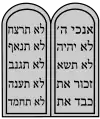| Arioch | |
|---|---|
| King of Ellasar[1](Sellasar) | |
| House | Ellasar |
| Part of a series on |
| Judaism |
|---|
   |
Arioch (Hebrew: אַרְיוֹךְ ’Aryōḵ) appears in the Book of Genesis[2] as the name of the "King of Ellasar", who participated in the Battle of the Vale of Siddim. The battle is described in Genesis as consisting of four kings, led by Chedorlaomer of Elam (Amraphel, Arioch, Chedorlaomer, and Tidal), engaging in a punitive expedition against five kings of Canaan who rebelled against Chedorlaomer (Bera, Birsha, Shinab, Shemeber, and the king of Bela). The same story is also mentioned in the Book of Jubilees, where Arioch is called "king of Sellasar".[3][4] According to Genesis Apocryphon (col. 21), Arioh was king of Cappadocia.
Arioch and Ellasar
Some historians have placed the area where Arioch ruled in Asia Minor, but theories as to its specific locations differ, with some claiming it was in Pontus while others cite Cappadocia and Antioch.[5] There are also sources which associated Ellasar with the kingdom of Larsa and suggested that Arioch could be one of its kings called Eri-Aku, an epithet of either Warad-Sin or Rim-Sin thus identifying Arioch as Warad-Sin or Rim-Sin since both Eri-Aku and Rim-Sin(or Warad sin) are described as son of Kudur-mabuk.[6]
Tablet of Kudur-mabuk mentioning Eri-Aku:[6]
To Nannara his king, Kudur-mabuk, father of Amoria son of Simti-šiḫak. When Nannara his prayer received, ne-zila-maḫa for Nannara for his life, and the life of Eri-Aku, his son, king of Larsa, he made
Tablet of Eri-Aku mentioning Kudur-mabuk, his father:[6]
Eri-Aku powerful hero everlasting shepherd installed by Bêl nourisher of Uriwa king of Larsa king of Šumer (and) Akkad son of Kudur-mabhuk father of Uamutbālu am I. In Uriwa broad, possessing an exalted name, to the peerless(?) supplication I have made. Nannara my king I have obeyed(>): A great wall, high ligh like a mountain impregnable, inspiring (?) its fear, have I made, its city may it protect. That wall "Nannara the consolidator of the foundation of the land" is its name.
By the 20th century, this theory became popular so that it was common to identify Arioch with Eriaku—through the alternative reading of either Rim-Sin or his brother Warad-Sin, who were both believed to be contemporary with Hammurabi.[7] Others identify Ellasar with Ilan-Sura which is a city known from second millennium BC Mari archives in the vicinity of north of Mari, and Arioch with Arriwuk who appears in Mari archives as a subordinate of Zimri-Lim.[8][9]
Adaptations by later writers
Arioch was a name for a fictional demon, and also appears as the name of a demon in many grimoires. Arioch is also named in John Milton's Paradise Lost (vi. 371.) as one of the fallen angels under Satan's command.
Arioch is one of the principal lords of Chaos in several of Michael Moorcock's fantasy series.
Arioch is one of the seventeen megatherians mentioned in Gene Wolfe's Briah Cycle.
References
- ↑ "Genesis 14:1 in those days Amraphel king of Shinar, Arioch king of Ellasar, Chedorlaomer king of Elam, and Tidal king of Goiim".
- ↑ Book of Genesis, chapter 14
- ↑ "Book of Jubilees: The Book of Jubilees: The Campaign of Chedorlaomer (xiii. 22–29)". www.sacred-texts.com. Retrieved 2016-05-07.
- ↑ Paula M. McNutt (1999). Reconstructing the Society of Ancient Israel. Louisville, KY: Westminster John Knox Press. p. 41. ISBN 978-0-664-22265-9. hd28MdGNyTYC&pg=PA41.
- ↑ Fitzmyer, Joseph (2004). The Genesis Apocryphon of Qumran Cave 1 (1Q20): A Commentary. Rome: Editrice Pontifico Istituto Biblico. p. 232. ISBN 8876533184.
- 1 2 3 Pinches, Theophilus (1908). The Old Testament In the Light of The Historical Records and Legends of Assyria and Babylonia (third ed.). London: Society for Promoting Christian Knowledge. pp. 218-220.
- ↑ Price, Ira, 1904. Some Literary Remains of Rim-Sin (Arioch), King of Larsa, about 2285 B.C. Chicago: University of Chicago Press. pp. 3–4.
- ↑ Walton, John H., and Craig S. Keener. NRSV Cultural Backgrounds Study Bible: Bringing to Life the Ancient World of Scripture. Zondervan, 2019. p. 39.
- ↑ K.A. Kitchen, On the Reliability of the Old Testament [OROT], William B. Erdmans Publishing, 2003. p. 320.